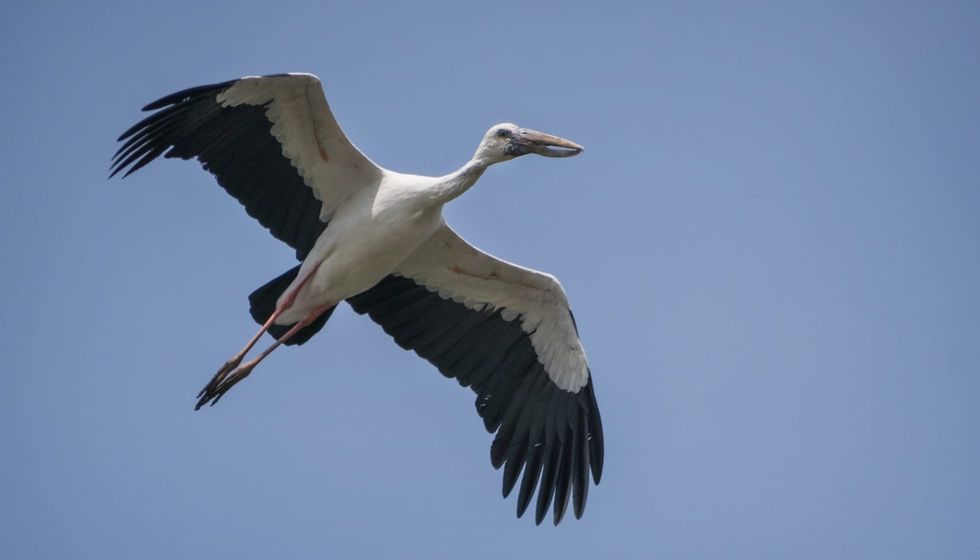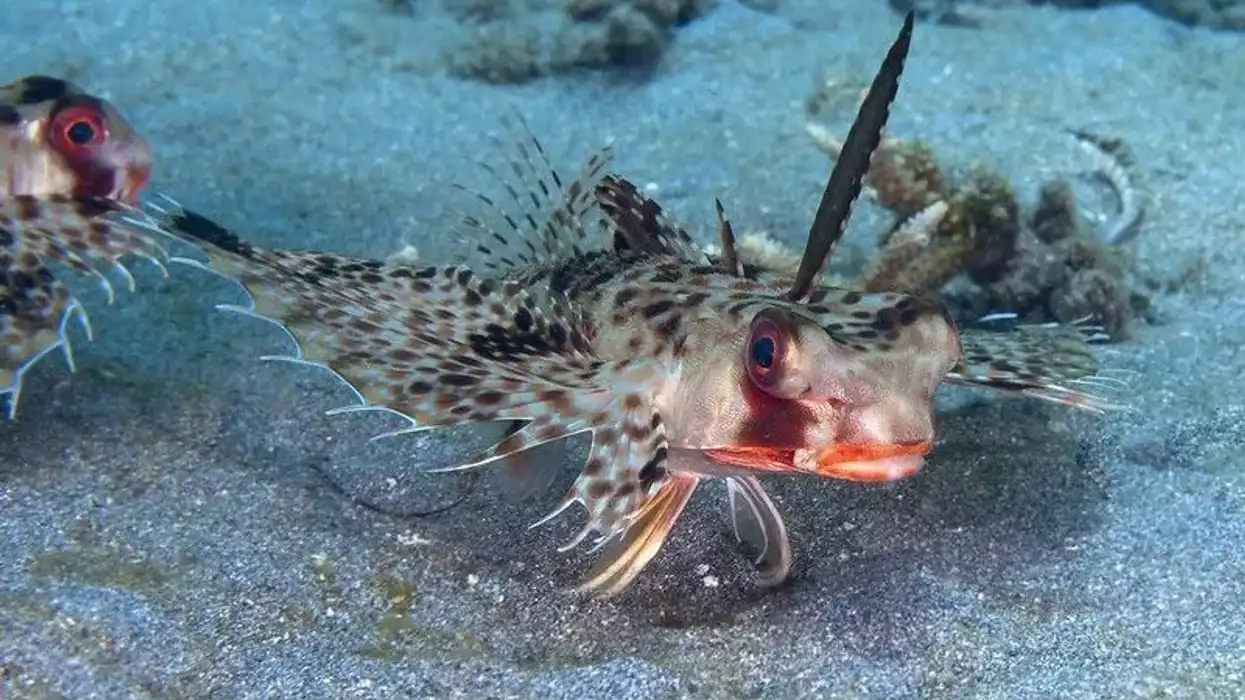An Asian openbill or Asian openbill stork (Anastomus oscitans) is among the wading storks from the family Ciconiidae. It has a weirdly shaped bill with a hollow gap formed by its curved lower mandible.
Among the species of the large wading bird, an Asian openbill, Anastomus oscitans, is relatively small in size with an open bill. Like all storks, it flies with its neck outstretched in the air.
The Asian openbill storks live in colonies with several nests on a single tree. They range from South Asia to Southeast Asia including Thailand, Nepal, Cambodia, Myanmar, India, and Sri Lanka.
They belong to the genus Anastomus – the name is derived from an Ancient Greek term anastomoō which typically stands for 'with mouth wide opened'.
The birds are called Asian open-billed stork, Indian open-billed stork, oriental open-billed stork, or the openbill stork. The gap between the upper and lower mandible is formed with age, which is speculated to be formed by foraging and feeding upon snails as it is the main food component.
If the uniqueness of the Siberian ibex makes you interested to read more about similar species, you can read about green heron and sanderling.
Asian Openbill Interesting Facts
What type of animal is an Asian openbill?
The Asian openbill, Anastomus oscitans, is a small stork with a distinctive bill among the species of large wading bird. The size of the openbill stork is relatively small for a stork. With a hollow gap between the mandibles, it is also known as an Asian (Indian or oriental) open-billed stork or openbill stork.
What class of animal does an Asian openbill belong to?
With a size small for a stork relatively smaller than the large wading birds, an Asian openbill stork (Anastomus oscitans) belongs to the class Aves and family Ciconiidae. More specifically, it belongs to the genus Anastomus. Also, its scientific name emerges from the genus name against a specific Latin epithet 'oscitans' meaning 'yawning'.
How many Asian openbills are there in the world?
No search reports are computing the size of the populations of Asian openbill storks. However, the Asian openbill stork, Anastomus oscitans, is recorded to have no major risks except their predators, the eastern imperial eagle, steppe eagle, and greater spotted eagle, and sportsmen hunting for meat.
Where does an Asian openbill live?
The Asian openbill stork or Asian openbill, Anastomus oscitans, inhabits South Asia and Southeast Asia. The Asian openbill range map highlights many Asian countries including India, Thailand, Sri Lanka, Pakistan, Bangladesh, Nepal, Myanmar, Cambodia, and to some extent China.
Its distribution remains varying throughout the countries. For instance, it is quite rare in Punjab, India, while the birds drift away from the southeast coast of India due to the lighthouses installed in August-September.
What is an Asian openbill's habitat?
The Asian openbill or Asian openbill stork, Anastomus oscitans, is recorded to nest around inland wetlands. The habitat of the Asian openbill storks ranges from agricultural landscapes, seasonal marshes, and wetlands. The birds are recorded feeding through the shallow water bodies.
Who do Asian openbills live with?
The openbill storks live and nest in colonies. It builds its nest on the trees, also, there are several nests found on trees.
The flocks of the birds are often found on breeding and feeding grounds around their favorable habitat. The birds also share their nesting trees with little egrets, darters, and great cormorants. Also, they are quite common around the regions inhabited by snails, as the birds are known to make movements depending on the availability of food.
How long does an Asian openbill live?
While the search reports lack an estimated lifespan of an Asian openbill, Anastomus oscitans, like all storks, the Asian openbill stork is speculated to live up to 30 years.
How do they reproduce?
The breeding season commences post rains from October to April in Thailand, although, the Asian openbill stork's breeding season varies from location to location. Adult breeding is skipped during years of drought. Furthermore, the breeding takes place in colonies.
Both the parents incubate the eggs for 25 days before they hatch into Asian openbill chicks. The adults (females) lay two to four eggs in their nests. The adults also share their nests and lay eggs in the same nest, too.
What is their conservation status?
The Asian openbill stork is categorized as Least Concern under the IUCN Red List of Threatened Species.
Asian Openbill Fun Facts
What do Asian openbills look like?
The length of an Asian openbill stork is relatively small for a stork but similar to the storks, it flies with its neck outstretched. The bird is not dimorphic but variations are recorded between non-breeding and breeding birds.
The bird has a gray plumage in the non-breeding season and a white-black plumage during its breeding season. During, the non-breeding season, the bird lacks glossy black wings and green-purple sheen. The movement of the bird is recorded between thermals of hot air for sustained flights.
While the adults have an open bill with an arched upper and curved lower mandibles with a hollow gap, young birds lack this gap. The gap between the mandibles typically grows with age while foraging and feeding upon the species of snail. The bill is yellow-gray in color while the legs are bright red-orange.
Young birds have a brown tint to their pelage.

How cute are they?
With a head smaller than its weirdly shaped beak, an Asian openbill stork is sure to attract you. Its red-orange legs and the gap between the mandibles are distinctive features making it a unique stork.
How do they communicate?
There are no reports regarding the communication methods of the Asian openbill stork. It is speculated to be a loud species but not as loud as white bellbird.
How big is an Asian openbill?
While the length of the Asian openbill ranges up to 32 in (81 cm), it is 26.7 in (68 cm) tall.
How fast can an Asian openbill fly?
While the range of flying speed of the Asian openbill remains undeciphered, however, it cannot be faster than a peregrine falcon.
How much does an Asian openbill weigh?
The weights of the adults and juveniles range between 3-20 lb (1-9 kg).
What are the male and female names of the species?
There are no sex-specific names of an Asian openbill.
What would you call a baby Asian openbill?
A baby Asian openbill stork can be called a chick, hatchling, nestling, or fledging.
What do they eat?
The openbill stork feeds on mollusk, frog, snail, snake, and other large insects. Since snails are its primary food, they assist the farmers in protecting their rice crops from the pest apple snail.
Are they rare?
While an Asian openbill may be considered rare around the world, it is not rare in Southeastern Asian countries including Thailand, Sri Lanka, and India. It is quite common through the south to southeast Asia.
Would they make a good pet?
No, openbill stork does not make a good pet as it is a wild species. It is better kept free rather than in captivity.
Did you know...
The openbill stork flies with its neck outstretched in the air.
The movement of the bird is recorded between thermals of hot air for sustained flights.
The Asian openbill storks are not Endangered and are of Least Concern under the IUCN Red List of Threatened Species.
The openbill stork is known to travel long distances considering the favorable climate and its feeding habits, snails being the primary component of the Asian openbill stork diet.
How did the Asian openbill get its name?
The gap between the mandibles and Asia as its native location justifies the name of an Asian openbill stork.
What's unique about an Asian openbill?
The mandibles intersect at the edge leaving a gap in its bill, hence, the open bill is unique to an openbill stork. While the gap does not exist right after birth, it develops considering its feeding habit with the snail as the primary food.
Here at Kidadl, we have carefully created lots of interesting family-friendly animal facts for everyone to discover! Learn more about some other birds from our reddish egret facts and glossy ibis facts for kids.
You can even occupy yourself at home by coloring in one of our free printable Asian openbill coloring pages.










